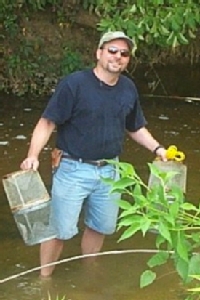Research questions environmental safety of flame retardant
A study by VIMS graduate student researcher Mark La Guardia provides new evidence of the release and environmental accumulation of a common flame-retardant chemical. His findings come in light of a recent voluntary decision by the main U.S. manufacturer of two other closely related and widely used flame retardants to discontinue their production.
La Guardia is a graduate student under Professor Dr. Rob Hale in VIMS’ Department of Environmental and Aquatic Animal Health. Hale is a leading expert on the environmental fate and effects of polybrominated diphenyl ethers (PBDEs), a class of chemicals added to many household foam and plastic products to reduce their flammability.
The Great Lakes Chemical Corporation will stop making the PBDE flame retardants known as Penta and Octa by December 2004, based on growing evidence that the chemicals are toxic, persist in the environment, bioaccumulate, and that people are being exposed. Scientists at VIMS and elsewhere have detected rising levels of these compounds in fish, sewage sludge, and human breast milk.
 La Guardia’s research deals with the third member
of the PBDE
family, known as Deca, which is the most widely used PBDE flame retardant in
the world. Until recently, most researchers thought that Deca—unlike Penta and
Octa—posed relatively little environmental risk.
La Guardia’s research deals with the third member
of the PBDE
family, known as Deca, which is the most widely used PBDE flame retardant in
the world. Until recently, most researchers thought that Deca—unlike Penta and
Octa—posed relatively little environmental risk.
That’s because they believed Deca was not in a form readily available to organisms, knew of no obvious pathways by which the compound could enter the environment, and because it was considered non-toxic.
But La Guardia’s findings add to a growing body of evidence that Deca is entering natural systems in large amounts and may breakdown to more toxic and bioaccumulative products. These products may impact normal development of the nervous system, which may, in turn, affect memory and learning in young animals, including humans.
In his study of a freshwater mid-Atlantic stream, La Guardia found extremely high concentrations of Deca, although the exact source of the compound remains unknown. He also found that the stream’s sunfish are taking up BDE-209, the main com- pound in Deca, and appear to be breaking it down into other, more hazardous PBDE compounds.
La Guardia notes that “Deca is in the environment, it’s in fish, and it may be breaking down into other PBDE compounds with suspected health risks.”
La Guardia presented his findings at the annual meeting of the Society of Toxicology and Environmental Chemistry (SETAC) in Austin, TX in early November.

